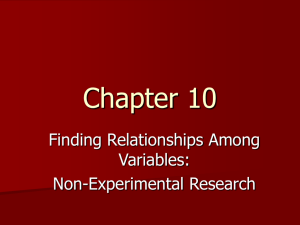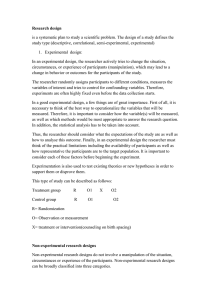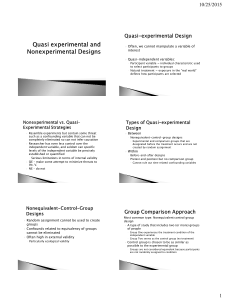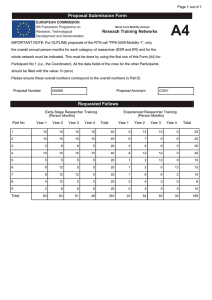Ch 9 Methodology
advertisement
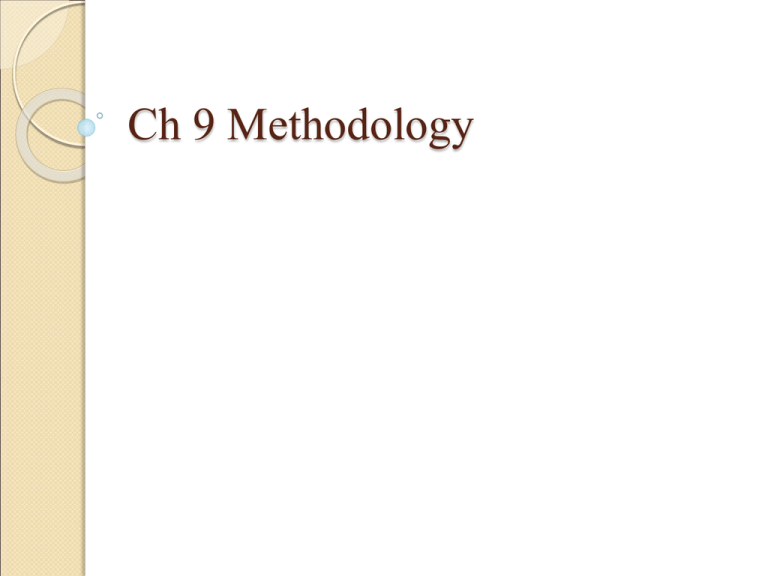
Ch 9 Methodology Research Design What is the research question? (What is the hypothesis?) Who are your population? Time and Budget Define types of the research 1.Quantitative Research 2.Qualitative Research Looking for the exist instrument or establishing a new instrument Data analysis Plan the research procure Research Design (Continued) Get the permission Do the survey Collect data Analyze the data Final report Quantitative Research Design Types of Quantitative Research 1. Survey Research Designs -- Cross Sectional Research Designs -- Longitudinal Studies 2. Experimental Research Designs 3. Quasi Experimental Research Designs 4. Causal-Comparative Research Designs 5. Correlational Research Designs Survey Research Major Characteristics -- Information is collected from a group of people in order to describe some aspects or characteristics of the population of which the group is a part -- Information is collected through asking questions; the answers to these questions by the members of the group constitute the data of the study -- Information is collected from a sample rather than from every member of the population Survey Research (Continued 1) Purpose of Survey Research -- To describe the characteristics of a population -- To determine how a population distributes itself on one or more variables Types of Surveys 1. Cross sectional -- Information that is drawn from a predetermined population -- Information is collected at one point in time -- A census would be typical Survey Research (Continued 2) 2. Longitudinal -- Information is collected at different points in time to determine changes over a period of time -- Trend studies would be typical-changing population surveyed at different times -- Panel study-survey same population at different times during the course of the study Survey Research (Continued 3) Steps in Survey Research 1. Define the problem -- What is it the researcher wants to find out -- Establish research questions -- Establish research hypothesis (es) 2. Identify the target population -- Sampling will be discussed later -- Sampling will be based on your research problem and what population can best attest to your problem Survey Research (Continued 4) 3. Data gathering -- Direct administration: Need access to the entire sample or population Need time and /or facilities a. Mail survey -- Mailed to participants -- Request to complete surveys -- Request to return surveys -- Consent forms -- Confidentiality -- Return rate Survey Research (Continued 5) b. E-Mail / Web surveys c. Telephone survey 7. Personal interviews Advantages and Disadvantages of Survey Data-Collection Methods Direct Administration Telephone Mail Interview Comparative cost Lowest Same Same High Facilities needed? Yes No No Yes Require training of questioner? Yes Yes No Yes Data collection time Shortest Short Longer Longest Response rate Very high Good Poorest Very high Group administration possible? Yes No No Yes Allow for random sampling? Possibly Yes Yes Yes Require literate sample? Yes No Yes No Permit follow-up questions? No Yes No Yes Encourage response to sensitive topics? Somewhat Somewhat Easy Hardest Standardization of responses Easy Somewhat Easy Hardest Advantages and Disadvantages of Closed-Ended vs. OpenEnded Questions Advantages Enhances consistency of response across respondents Easier and faster to tabulate More popular with respondents Allows more freedom of response Easier to construct Permits follow-up by interviewer Disadvantages May limit breadth of responses Takes more time to construct Requires more questions to cover the research topic Responses tend to be inconsistent in length and content across respondents Both questions and responses subject to misinterpretation Hard to tabulate and synthesize Preparing the Instrument Questionnaire 1. Appearance 2. Questions clear --- Is this a question that can be asked exactly the way it written? --- Is this a question that will mean the same thing to everybody? --- Is this a question that people can answer? --- Is this a question that people will be willing to answer, given the data collection procedures? --- Pilot test Preparing the Instrument (Continued 1) Types of questions 1. Open-ended Used if you want an individuals true feelings Gives people an opportunity to individualize responses 2. Close- ended Respondents can select responses from a number of options Questions need to be unambiguous Keep the focus as simple as possible Keep questions short Preparing the Instrument (Continued 2) 2. Close- ended Use language the respondents will be familiar with Avoid using terms that might bias responses Avoid leading questions Avoid double negatives 3. Pilot Test 4. Format and cover letter There are several different sources that will assist the researcher to format their questionnaire and cover letter Preparing the Instrument (Continued 3) 5. Nonresponse Send reminders Can create an additional sample until desired number is reached May have to discard surveys if there are missed questions 6. Obtain demographics that will be pertinent to the study Causal-Comparative Research Definition 1. An attempt to determine the cause or consequence of differences that already exist between two or more groups of individuals 2. Sometimes called correlational research --- Seeks to explore relationships among variables --- Identifies variables for further research --- Differs in that it compare groups rather than scores --- Differs as it usually has group members rather than quantitative variables Causal-Comparative Research (Continued 1) 3. Used to study differences between groups (malefemale) 4. Looks for noted differences between groups and causes or consequences of the difference 5. Can be used as a substitute for experimental research the only difference would be that in experimental research the independent variable is manipulated by a treatment 6. This is non-experimental research 7. Describe current conditions (cancer) 8. Identify or explore the past for causes of the a current condition (smoking) Examples of the basic Causal-Comparative Design (a) Group Independent Variable Dependent Variable I C O Giving a little gift Level of customer satisfaction (-C) O Not giving a little gift Level of customer satisfaction Group Independent Variable Dependent Variable I C1 O Counselors Amount of job satisfaction C2 O Teachers Amount of job satisfaction II (b) II Steps Involved in Causal-Comparative Research 1. Problem * Establish the phenomena and cause or consequences * Once established become more specific * Develop hypothesis (es) by comparing the variables with the causes that have been developed through your research problem * How does one variable effect the other (independent variable’s effect on the dependent variables) Steps Involved in Causal-Comparative Research ( Continued 1) 2. Sample Define the characteristic to be studied with the idea of selecting a group that would be differing in regards to the characteristic but similar with one characteristic (male-female) (9th grade-11th grade) 3. Instrument Open-end 4. Design Select two or more groups that differ on at least one variable but may be similar in another Steps Involved in Causal-Comparative Research ( Continued 2) 5. One group possesses a characteristic (criteria) the other group don’ Investigate a categorical variable vs. a quantitative variable (group vs. score) 6. Data analysis * Compare the differences in means using t-test or analysis of covariance * Use frequency polygons * Just report the cause and the effect do not try to prove causes or effects Correlational Research Definition 1. The relationships among two or more variables are studied without any influence or treatment 2. It describes an existing relationship between variables 3. Scores within a certain range on one variable are associated with scores within a certain range on the other variable Correlational Research (Continued 1) Purposes 1. Explain important human behaviors To clarify our understanding of important phenomena by identifying relations between variables 2. Prediction studies * Based on a high relationship between two variables it becomes possible to predict a score on either variable if the score on the other variable is known * Scattergram -- Ordinate-vertical axis -- Abscissa-horizontal axis -- Regression line-line that comes closest to all scores depicted may reflect a perfect correlation 3. There are many complex correlational techniques Correlational Research (Continued 2) Basic Steps in Correlational Research 1. Problem Selection * The relationship two or more variables * The differences between two or more variables 2. Sample * Represent the research variables * Should be selected randomly * Need 30 or more participants for meaningful results 3. Instruments * Need to measure two or more variables * Need to yield qualitative data Correlational Research (Continued 3) 4. Design * Two scores are obtained from each participant * One score for each variable 5. Data analysis * Correlation coefficient is produced * A decimal between 0.00 and 1.0 * The closer to 1.0 the coefficient establishes a stronger relationship * A correlation 3.5 show only a slight relationship between variables * Correlations between .40 and .60 may have theoretical or practical value * Correlations of .65 or higher one can make reasonable predictions * Correlations over .85 have a strong relationship between variables Experimental Research What is it? * Research that directly attempts to influence a particular variable * Looks at the effect of an independent variable on one or dependent variables * Independent variable is the experimental or treatment variable * Dependent variable is the criterion or outcome variable * Researchers manipulate the independent variable --- Researcher decide on the treatment What is going to happen to the subject? To whom is the treatment going to be applied To what extent is the treatment going to be applied more Experimental Research (Continued 1) * Comparison of groups Experimental group receives the treatment Control group receives no treatment Comparison group receives a different treatment Randomization * Random selection: every member of the population has an equal chance of being selected to be a member of the sample * Random assignment: any of the participants has an equal chance of being assigned to any of the groups Takes place before the experiment takes place It’s a process of assigning not just a distribution Experimental Research (Continued 2) The groups should be equivalent (as much as human being can be) Has the possibility of eliminating extraneous variables that might effect the outcome of the study by controlling for the characteristics that might have an impact * Overcoming extraneous variables --- The researcher has more control over the research than in other research designs a. Researcher determines the treatment b. Researcher selects the sample Experimental Research (Continued 3) * Overcoming extraneous variables --- The researcher determines the treatment --- The researcher selects the sample --- The researcher assigns individuals to groups --- The researcher decides which group will get the treatment, controls and different treatment --- The researcher controls for outside factors that might influence the study a. The researcher observes or measures the effect of the treatment on the groups when the treatment is completed Experimental Research (Continued 4) --- Ways the researcher can minimize threats due to subject characteristics a. Randomization-assume individuals within a group will have different characteristics b. Control variable by removing it from the study c. Build needed variable into the study (gender, age, culture, etc.) d. Match characteristics into the different groups e. Control subjects by giving them each specific treatments f. Control groups by grouping into certain variables based on pre-test, pilot test Experimental Research (Continued 5) * Weak experimental designs --- One shot study: single group is exposed to the treatment and dependent variable is measured without any controls --- One group pretest-posttest: measured before and after treatment to determine if there is any change in the dependent variable --- Static group comparison: pre-formed groups compared based on different treatments --- Example of a one-group pretest-posttest design Pretest: Twenty-item attitude scale completed by employees (Dependent variable) Treatment: Ten weeks of counseling Post-test: Twenty-item attitude scale completed by employees (Dependent variable) Experimental Research (Continued 6) --- Example of a one-shot case study design X ○ New textbook Attitude scale to measure interest (Dependent variable) --- Example of a static-group comparison design X1 ○ New rules Attitude scale to measure interest X2 ○ Old rules Attitude scale to measure interest Experimental Research (Continued 7) True experimental designs * Subjects are randomly assigned to treatment groups * Randomized posttest only control group design --- One group received experimental treatment the other is the control group, both groups are post tested on a dependent variable * Randomized pretest-posttest control group design --- Measured at the pretest and measured again at posttest to determine whether there has been any change in the dependent variable Experimental Research (Continued 8) Randomized Solomon four group design --- Two groups are pretested and two are not --- One of the pretested and one of the non-pretested groups are exposed to treatment --- Two of the groups are the control groups --- All four are posttested Example of a Randomized Posttest-Only Control Group Design R X1 O Random assignment of 50 employees to experimental group Treatment: sensitivity training workshops Posttest: Faculty morale questionnaire (Dependent variable) 100 employees randomly selected R X2 O Random assignment of 50 employees to control group No treatment: Do not receive sensitivity training Posttest: Faculty morale questionnaire (Dependent variable) Example of a Randomized Pretest-Posttest Control Group Design R O X1 O Random assignment of 50 employees to experimental group Pretest: Faculty morale questionnaire Treatment: sensitivity training workshops Posttest: Faculty morale questionnair e (Dependent variable) (Dependent variable) 100 employees randomly selected R O X2 O Random assignment of 50 employees to control group Pretest: Faculty morale questionnaire Treatment: Workshops that do not included sensitivity training Posttest: Faculty morale questionnair e (Dependent variable) (Dependent variable) Experimental Research (Continued 9) * Random assignment with matching --- Attempt to increase the likelihood that the groups of subjects in an experiment will be equivalent, participants would be matched on certain variables to insure equivalence on these variables --- The variables matched will be determined by the researcher a. Mechanical matching Pairing two persons based on similar scores on a particular variable If there is no match some subjects could be eliminated from the study Experimental Research (Continued 10) b. Statistical matching Based on a correlation a subject is given a predictable score on a dependent variable with the variable the subject is being matched Matches could occur based on pretest scores Quasi Experimental designs Does not include the use of random assignment but other control techniques Matching only design * Subjects are matched in the experimental and control groups based on certain variables * There are no assurances they are equivalent on other variables * Correlations used need to be significant (above 0.04) Counterbalanced designs * Another way of equating experimental and control groups * Each group is exposed to a treatment, but different groups will receive treatments at different times Quasi Experimental designs (Continued 1) Time series designs * Measurements or observations are at different times before and after treatment, whether pretest or posttest Factor designs * Extend the number of relationships * Study the interaction of the independent variable with more than one moderator variable (treatment or characteristic variable) * Uses a factor analysis statistic

